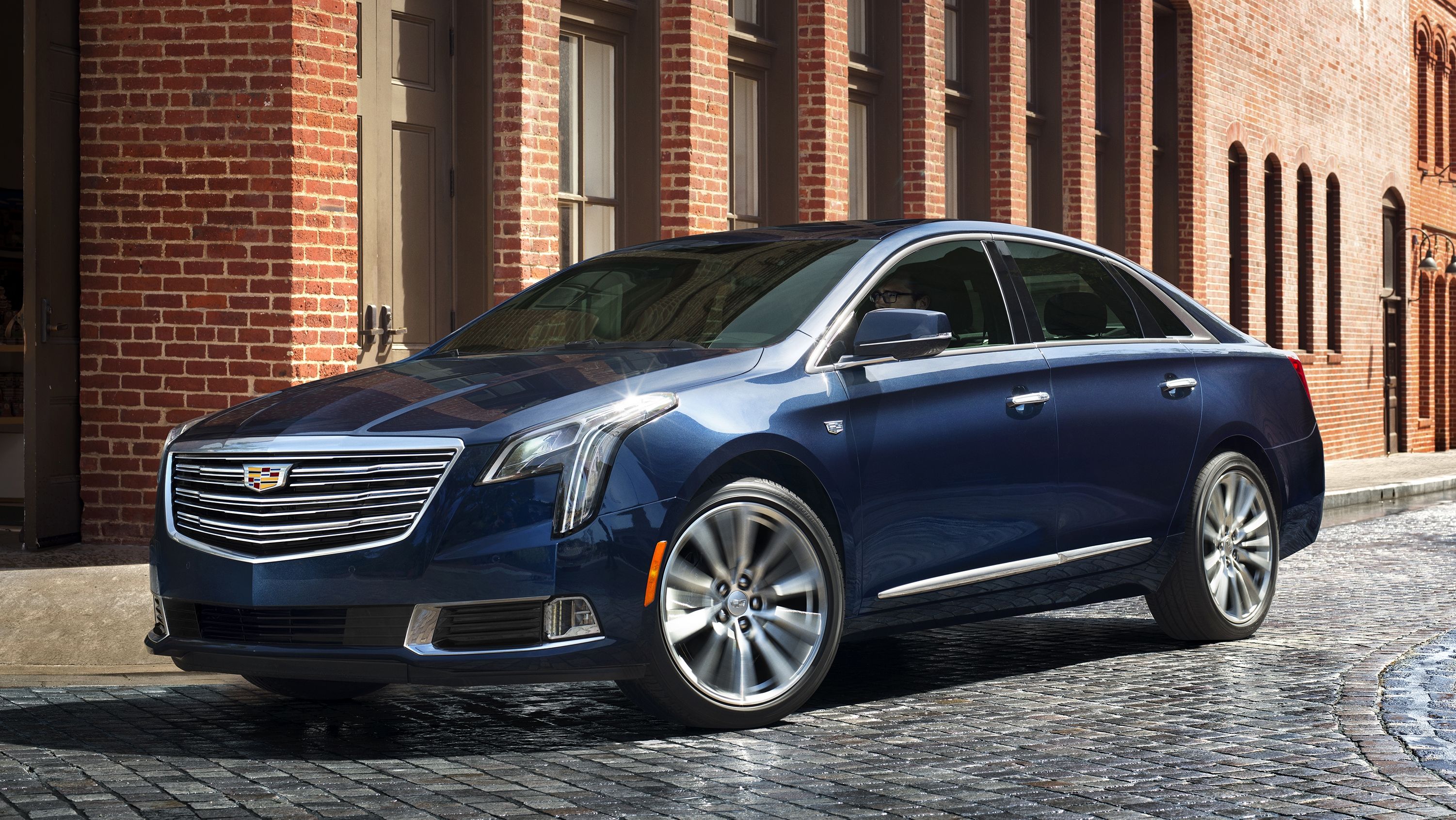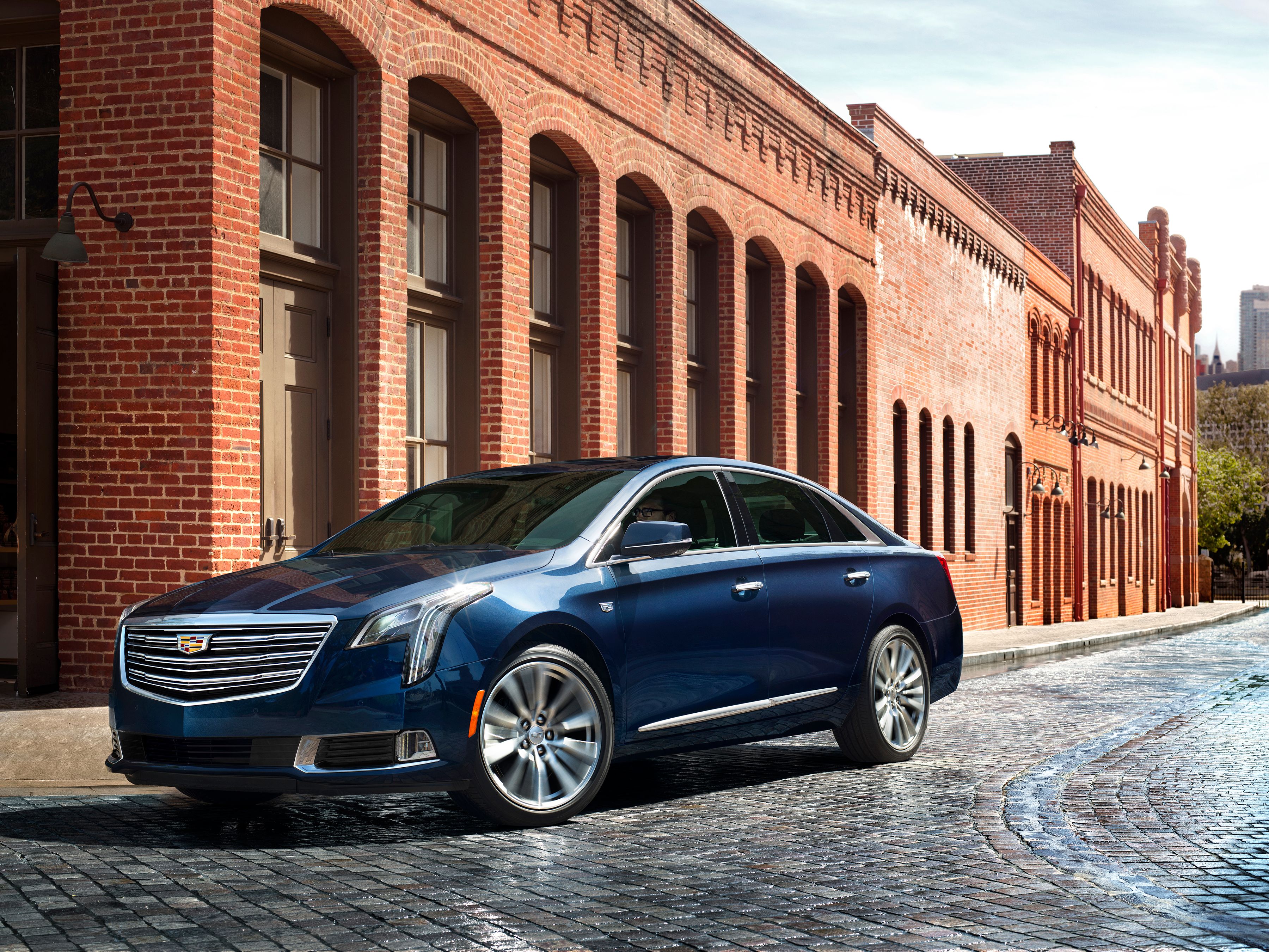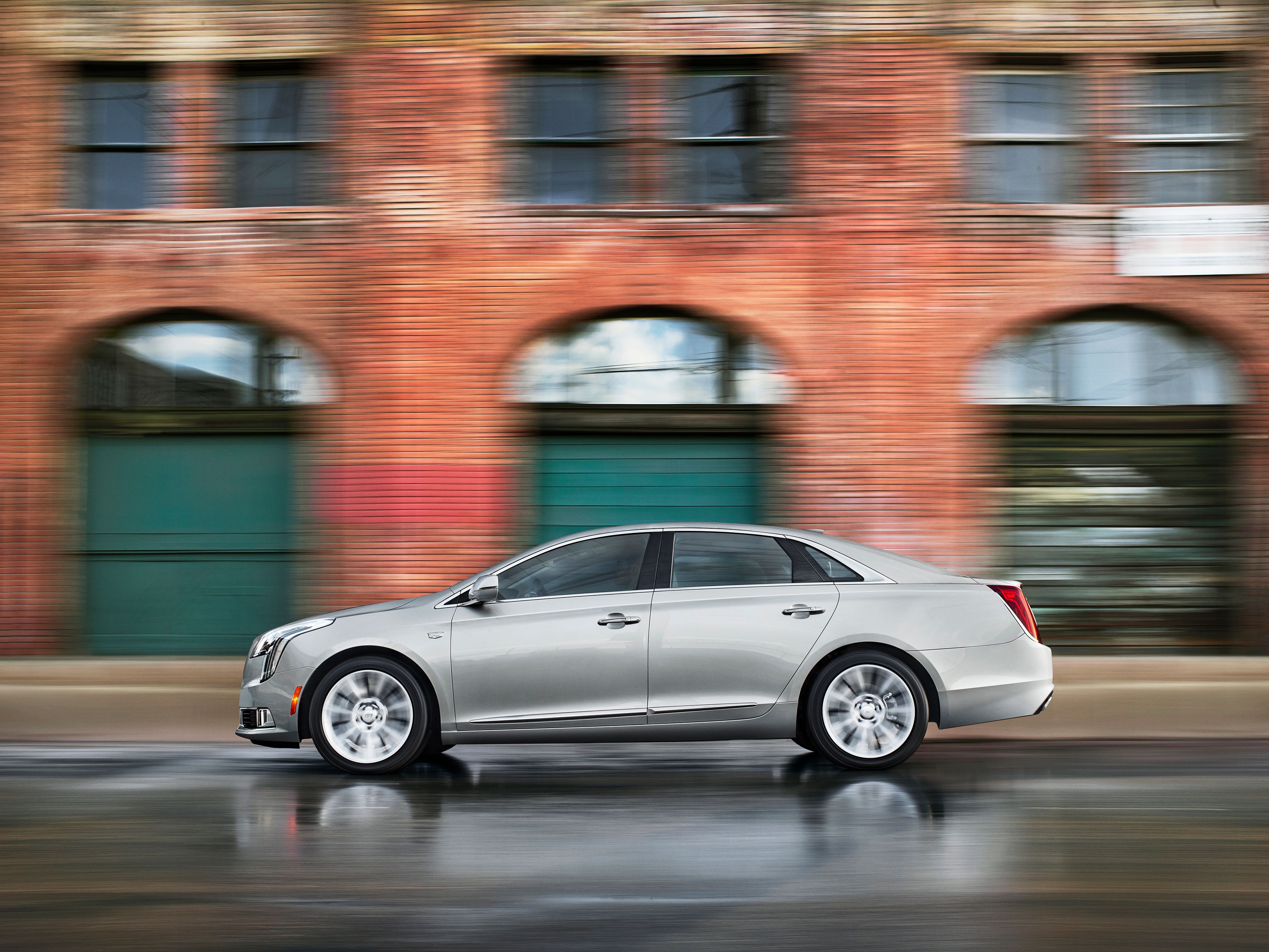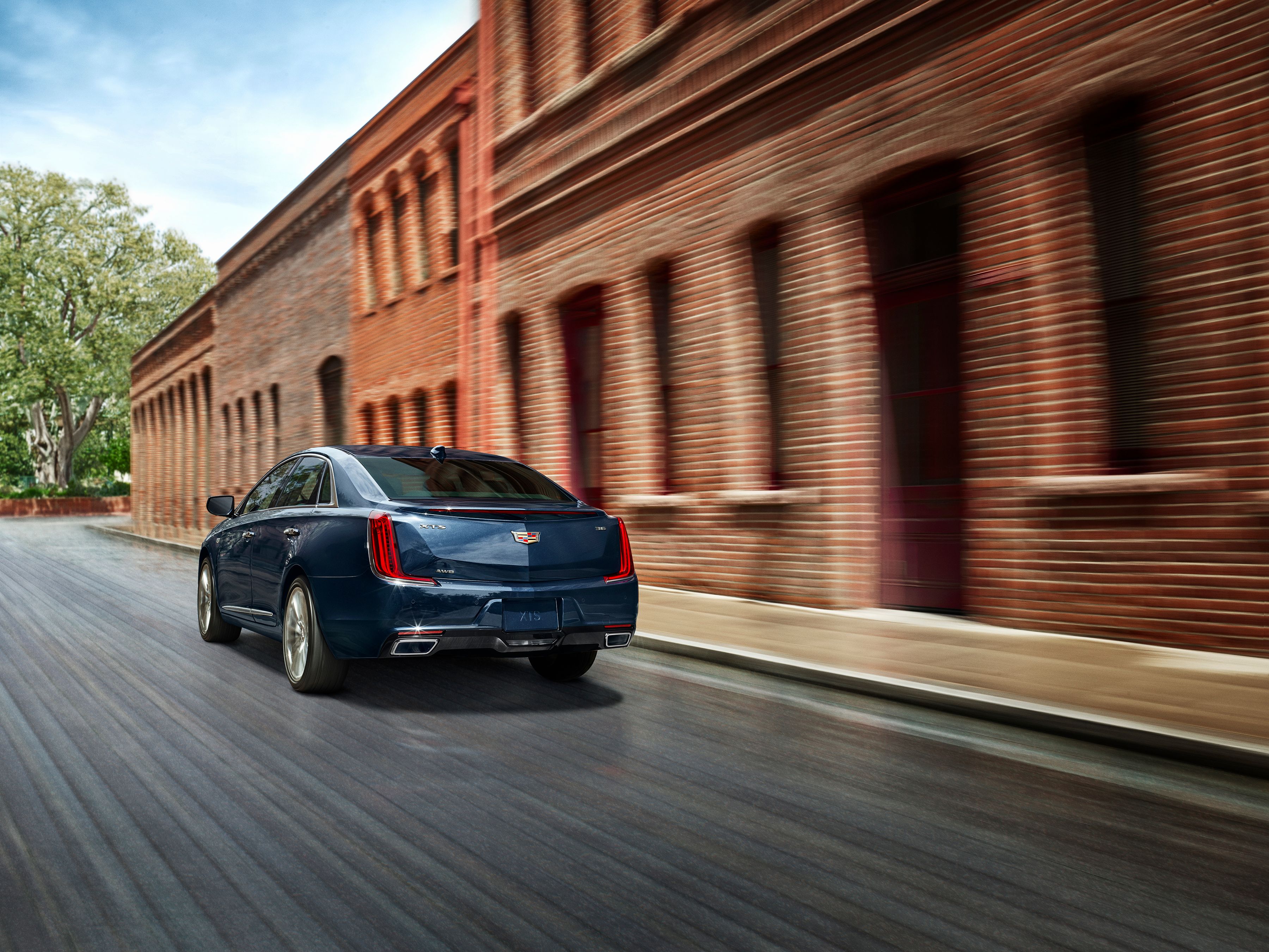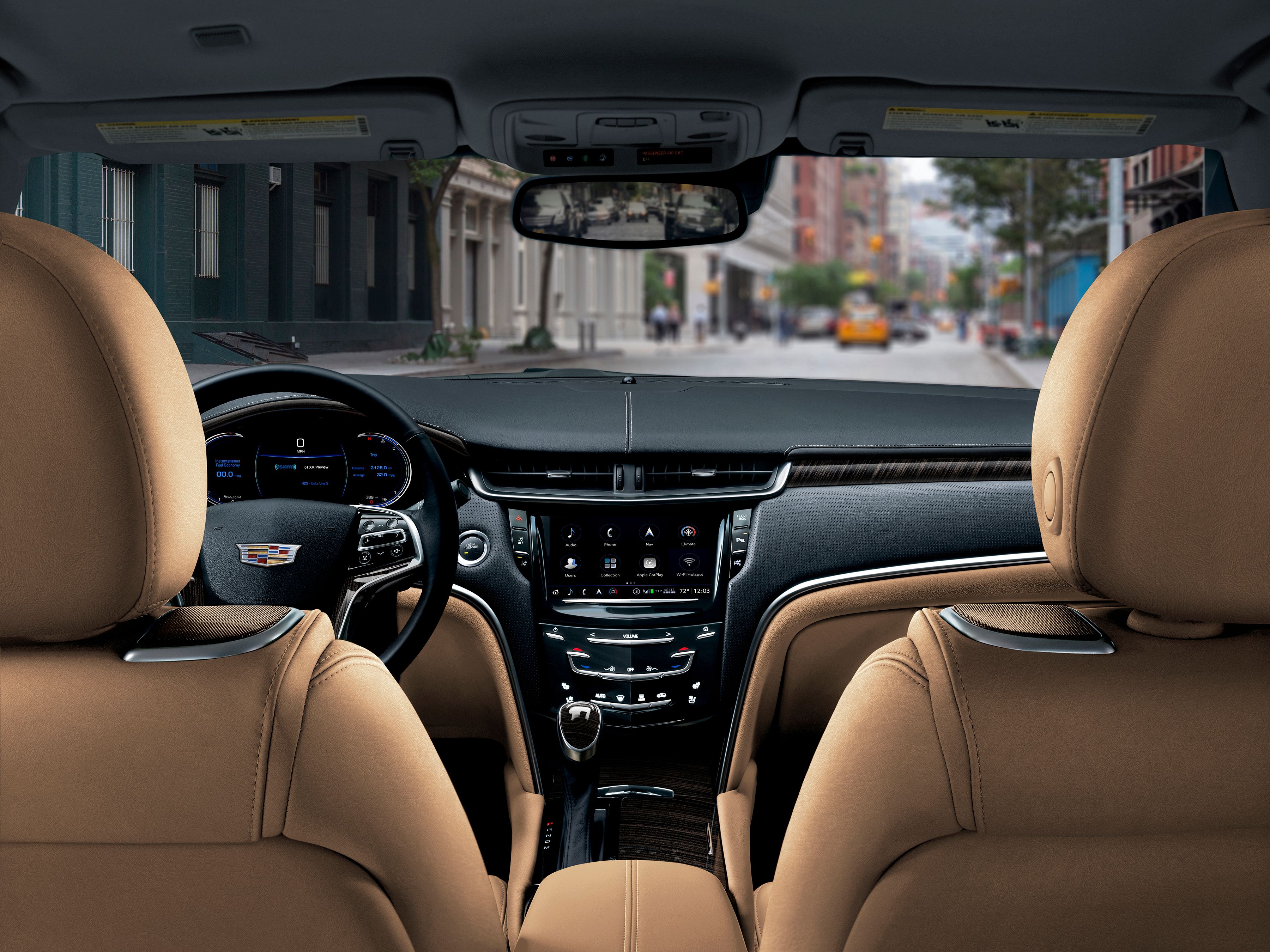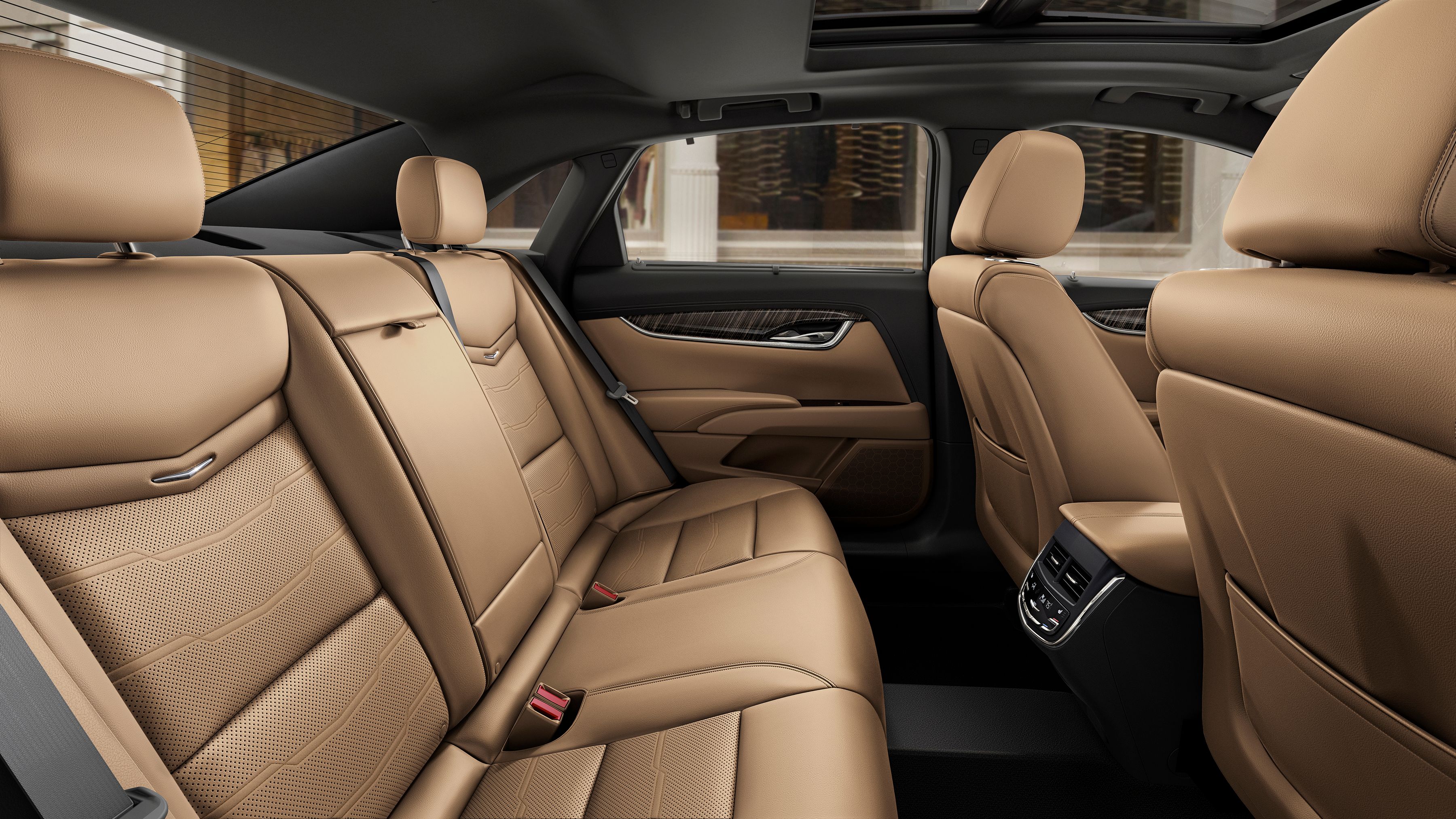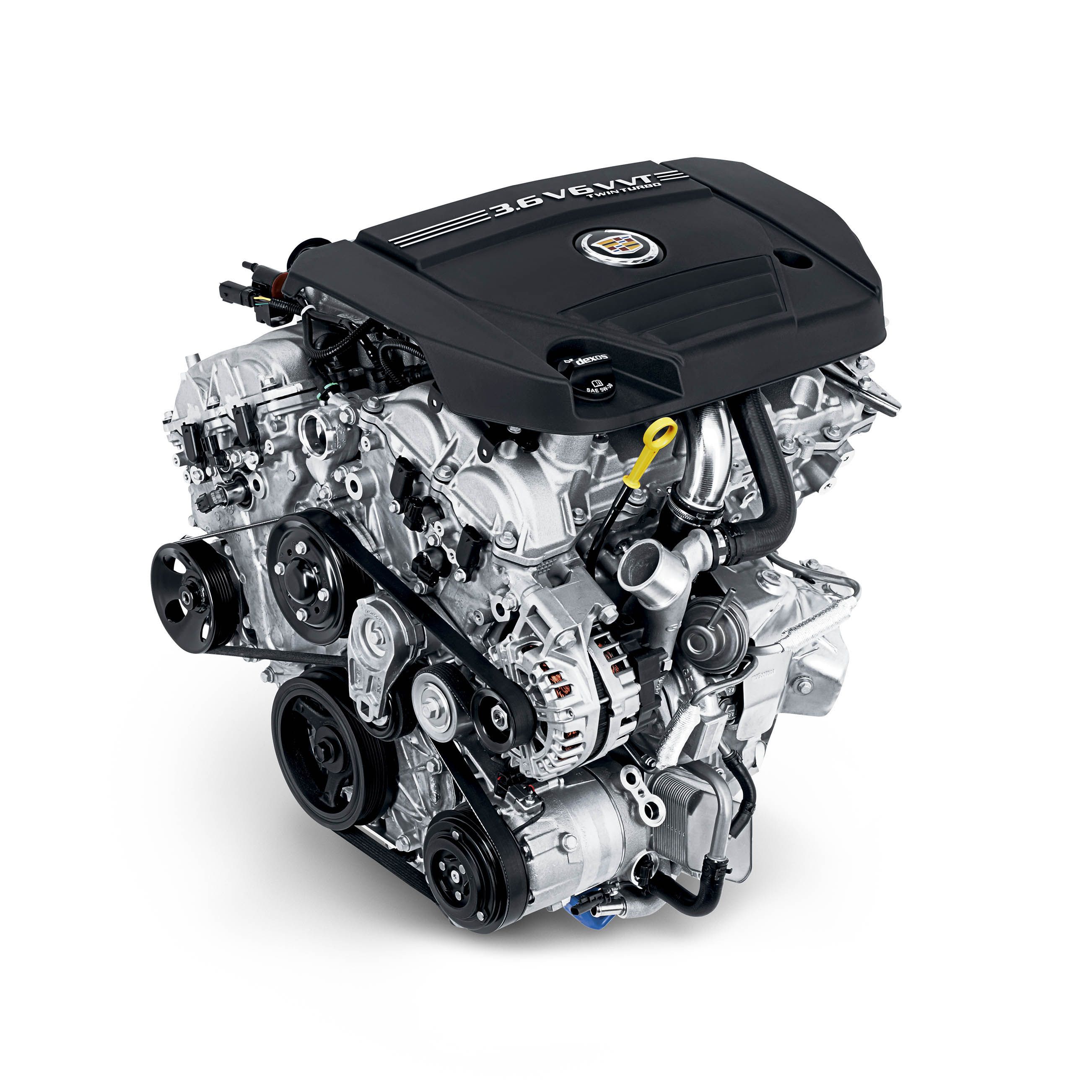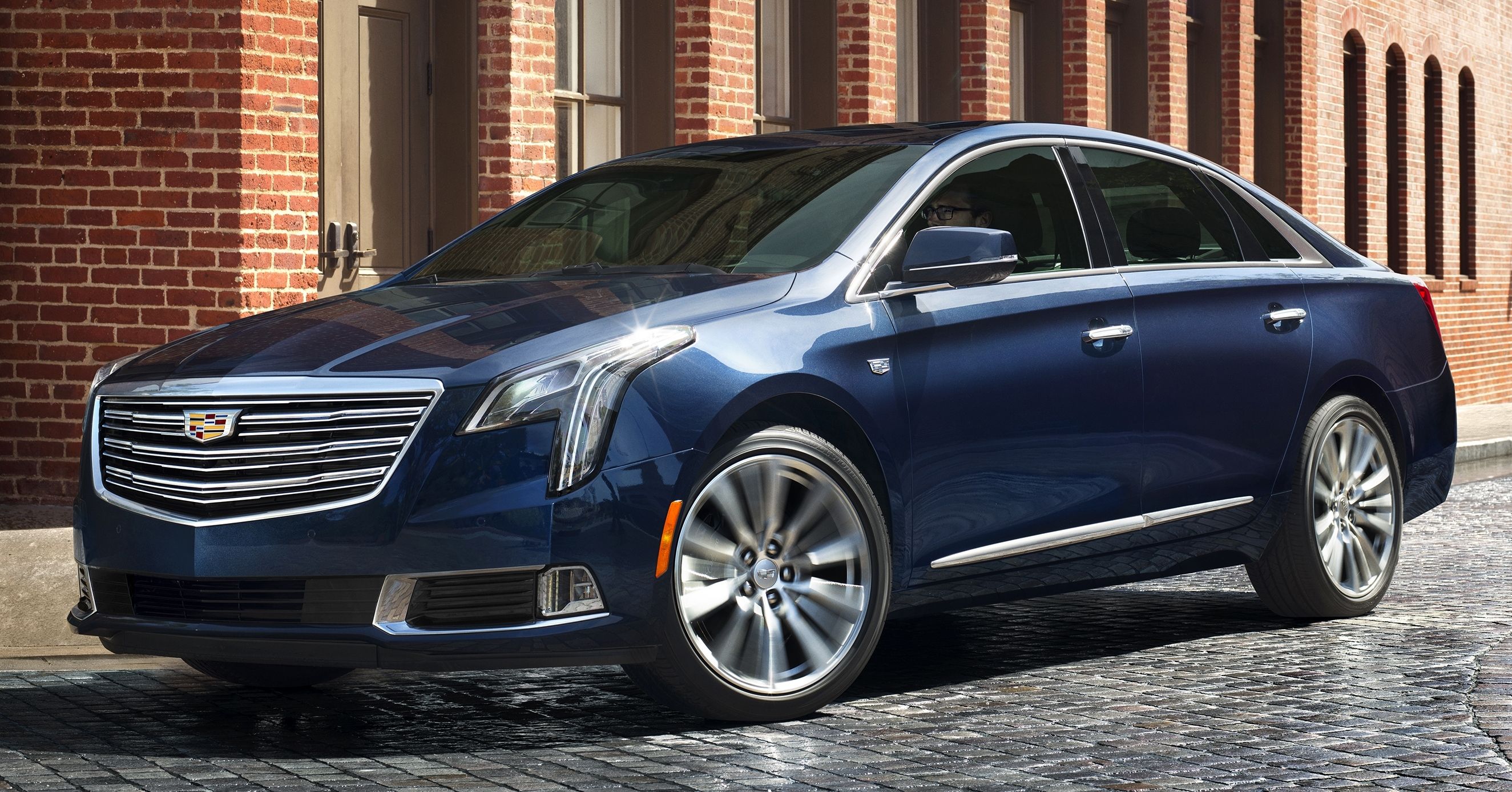Cadillac is an interesting brand. In a world where SUVs reign superior, Cadillac only has two – the XT5 and the Escalade. Meanwhile, it takes the “same sausage, different lengths” mentality to extremes with its entire lineup of cars that all look damn near the same. And, that gets even worse as we begin the painstaking transcendence into the 2018 model year, as the XTS has now been updated with Cadillac’s latest design cues, making it nearly identical to the CT6 that sits above it and the midsized CTS that sits below it. As such, this facelift brings about a new grille design, new front fascia, and new headlight and taillight units on the outside to go with an updated chassis under the skin, and some updated technology and new color/trim choices on the inside.
All told, the facelift is more refining than anything, but whether or not that’s a good thing remains to be seen. One this is for sure, though. The XTS has its work cut out for it if it’s going to be a strong competitor for models the Audi A6, BMW 5 Series, and the Mercedes-Benz E-Class. So will the updates for 2018 give the XTS the fighting chance it deserves, or will it scrape and claw its way through the muck that is the full-size luxury segment until Cadillac can manage to muster up a second-gen model? Let’s take a good look at what Cadillac brings to the table for 2018 and find out for ourselves.
2018 Cadillac XTS
- Make: Array
- Model: 2018 Cadillac XTS
- Engine/Motor: V6
- Horsepower: 304 @ 6800
- Torque: 264 @ 5200
- Transmission: six-speed automatic
- [do not use] Vehicle Model: Array
Exterior
The design of the 2018 Cadillac XTS is far from new, so if you were hoping to see something different from Cadillac this time around, you better look elsewhere. What we have here is the transference of DNA directly from the CT6, which brings about similar looking headlamps, Caddy’s latest grille design, and a redesigned fascia. While all of these things seem kind of old as they’ve already been showcased on the CT6, they are admittedly refreshing for the XTS as the old design wasn’t exactly something you would write home about.
As you can see, the outgoing model had those big bulky headlights, an uneventful grille, and a little air dam down below that made no sense as it was completely blocked off from the rear on most models anyway. For 2018, the grille has grown taller and now features three vertical louvers all finished in the same chrome as the garnishing that surrounds the grille. Flanking the grille is the redesigned headlights, which are still bulky and far from modern with the way they embrace the upper corners of the nose, but there are much more interesting now and feature LED lights as standard equipment. Of course, this also leaves a recessed imprint in the fascia where the cut used to be made for the old headlight units, so there’s some tackiness there as well. Down below, the corner vents have been redesigned and now feature a silver surround on the inside and smaller, square fog lights. The air dam is now smaller in width but sits a little taller. The black plastic that separates it from the corner vents is a little tacky as well but strangely works somehow… who knew?
There are no changes to the side profile to speak of outside of new wheel designs for the 19- and 20-inch wheel options. Around back, however, there are a few other refinements that do bring some extra value to Caddy’s cheaper full-size sedan. The rear fascia has been completely revamped and now has a license plate recess in the middle, officially bringing an end to the Acura-like beak appearance of the rear fascia. A new insert down below brings less chrome into the fold to go with smaller, repositioned reflectors. Up above, the rear deck lid now gets a center crease along with a body line that manages to connect both rear quarters together visually. The taillights are also new, with an all-new matrix layout and a little strip that feeds from the bottom and points toward the center point of the rear decklid. Finally, the high-mount brake light on top of the deck is now thinner and a little longer, giving the rear end a sleeker appearance.
All told, the 2018 XTS can be had in 10 different colors: Crystal White Tricoat, Black Raven, Radiant Silver Metallic, Phantom Gray Metallic, Bronze Dune Metallic, Dark Adriatic Blue Metallic and Stellar Black Metallic, with the addition of Red Horizon Tintcoat, Stone Gray Metallic, and Midnight Sky Metallic.
Exterior Dimensions
|
Wheelbase (Inches) |
111.7 |
|
Overall length (Inches) |
202 |
|
Overall width (Inches) |
72.9 |
|
Overall height (Inches) |
59.4 |
|
Track front/rear (Inches) |
62.3/62.5 |
Interior
When it comes to the interior of the 2018 XTS, you probably won’t notice any changes at all, unless you’re actually looking for them. To the untrained eye, the interior looks identical to the 2017 model, but there’s some changes under the skin that should make things a little more comfortable. As always, most of the interior trim is wrapped in leather and precision sewed to look extra fancy. The seats, however, get updated foam geometry (to make the bum happy), wire frame structure, and heat pads for the heated seats. On the aesthetic front, that’s about it for the interior with the exception of three new interior color/trim combinations:
Interior Color and Trim Options
|
Jet Black and Graphite Sapele Open Pore wood trim; leather seating surfaces |
|
New Shale with Jet Black accents and Graphite Sapele High-Gloss Natural Ash wood trim; leather seating surfaces |
|
Kona Brown with Jet Black accents and natural finish wood trim; full leather seating surfaces |
|
New Platinum-exclusive Jet Black High Gloss Ebony Lineate wood trim; Semi-Aniline full leather seats |
|
New Platinum-exclusive Maple Sugar with Jet Black accents and Nutella Lineate with high gloss Ebony Lineate wood trim; Semi-Aniline full leather seats |
But, it’s not all about the seats and trim inside the XTS, as this facelift also brought about updates to the infotainment system. Essentially a refinement of the system found in the current model, the 2018 XTS gets an eight-inch LCD touchscreen that features large icons similar to that of a smartphone and now allows for the use of in-vehicle apps from the Collection app store. It also offers up partial name recognition, personalized profiles, and an integrated, smartphone-like navigation system. It also serves as a display for the advanced park assist system and will now show you Wi-Fi signal strength. More importantly, however, is the fact that the system now includes a “summary view” which displays all key applications like climate controls, audio controls, phone controls, and navigation all up front for the driver, so there’s no need to dig around or take your eyes off the road to change the radio station or adjust the cabin temperature.
The standard audio system is a Bose eight-speaker system that includes four USB ports. Phone connectivity is available via Android Auto and Apple CarPlay, while a Wi-Fi hotspot allows multiple devices to make use of the car’s 4G LTE hotspot.
Other Interior Features
|
22-way power-adjustable front seats with heat, ventilation and massage are standard on Platinum models and available on Premium Luxury models. |
|
Adaptive remote start is standard on all models. |
|
Audio system with Bose® premium eight-speaker sound is standard on the XTS and Luxury models. |
|
Bose® Studio Surround Sound 14-speaker system with Surround Stage signal processing is standard on Premium Luxury and Platinum models. |
|
Tri-zone automatic climate control is standard on Premium Luxury and Platinum models. Dual-zone automatic climate control is standard on XTS and Luxury models. |
|
Color, reconfigurable 12.3-inch gauge cluster with driver information center is standard on Premium Luxury and Platinum models. |
|
Head-up Display with color readouts is standard on the Premium Luxury and Platinum models. |
|
Illuminated entry and courtesy lighting is standard on all models. |
|
Accent lighting, including LED spotlights and light pipes, is standard on Luxury, Premium Luxury and Platinum models. |
|
Full-leather seats with mini-perforated inserts are standard; Semi-Aniline full-leather seating surfaces with mini-perforated inserts are standard on the Platinum model XTS. |
|
Heated driver/front passenger and outboard rear passenger seats and vented driver/front passenger seats are standard on Luxury, Premium Luxury and Platinum models. |
|
Leather-accented steering wheel with wood accents and tap up/tap down transmission controls is standard. |
|
Heated steering wheel is standard on Luxury, Premium Luxury and Platinum models. |
|
Power rear window shade and manual rear side window shades are available on the Premium Luxury model and standard on Platinum. |
Interior Dimensions
|
Headroom front/rear (Inches) |
39/37.8 |
|
Legroom front/rear (Inches) |
45.8/40 |
|
Shoulder room front/rear (Inches) |
57.9/56.3 |
|
Hip room front/rear (Inches) |
55.1/54.3 |
|
Passenger volume (cu ft) |
104.2 |
|
Cargo volume (cu ft) |
18.0 |
Drivetrain
Under the hood, you’ll find Cadillac’s Familiar 3.6-liter V-6. In non V-Sport models, it is naturally aspirated and delivers 304 horsepower and 264 pound-feet of torque. Cadillac is able to shave some weight off of the engine by using a composite intake manifold and by integrating the cylinder head and exhaust manifolds, combined, this saves 18.5 pounds off traditional designs. Move up to the V-Sport model, and you’ll get that same 3.6-liter, but this time it’s equipped with twin turbos and a charge air cooler – just enough to push power output up to 410 horsepower and 369 pound-feet of torque. Both engines make use of direct fuel injection, variable valve timing, and dual overhead camshafts. V-Sport models see maximum torque as low as 1,900 rpm all the way up to 5,600 rpm.
Both versions of that 3.6-liter mate to a six-speed automatic transmission with tap-shift technology. Cadillac has yet to release official performance specs for the XTS in any form, but independent testing has shown that the V-Sport model can do the 60-mph sprint in as little as 5.2 seconds and tops out around 137 mph. The standard model likely does the same sprint in 6.4 seconds and tops out around 130 mph. Fuel economy ranges anywhere from 18 mpg in the city and 28 mpg on the highway in the base model to as little as 16 mpg in the city and 24 on the highway in the V-Sport model. All-wheel drive is optional while front-wheel drive is standard on most models.
While the engine and transmission offerings go unchanged for 2018, Cadillac did put in some work under the metal, where the chassis has supposedly been updated as have the 19- and 20-inch tire designs. This is said to improve ride comfort while reducing outside noise. Magnetic Ride Control and Rear Air Leveling suspension are available as an option. The optional all-wheel-drive system comes with an electronic limited-slip differential to control torque distribution between the rear wheels. Front-wheel-drive models get a premium electric, variable-assist power steering system that helps improve control and StabiliTrak is standard on all models to go along with Brembo brakes in the front, and four-channel anti-lock brakes.
Drivetrain Specifications
|
Engine |
3.6L V-6 VVT DI |
3.6L V-6 Twin-Turbo VVT DI |
|
Horsepower |
304 HP @ 6,800 RPM |
410 HP @ 6,000 RPM |
|
Torque |
264 LB-FT @ 5,200 RPM |
369 LB-FT @ 1,900-5,600 RPM |
|
Transmission |
Hydra-Matic 6T70 six-speed automatic |
Hydra-Matic 6T75 six-speed automatic |
|
Fuel economy |
18/28 |
16/24 |
|
0 to 60 mph |
6.4 seconds |
5.2 seconds |
|
Top Speed |
130 mph |
137 mph |
Pricing
Cadillac has yet to announce pricing for the 2018 model year, but given the minor changes that have come as a result of the facelift, I wouldn’t expect prices to stray that much. Pricing could increase across the board marginally, but I won’t expect to see more than a $1,000 increase to any one trim level. For 2017, the entry-level XTS starts out at $45,595, the Luxury trim comes in at $49,595, and the Premium Luxury comes in at $56,095. Moving up to the Platinum takes it up another $8k to $64,895 while the V-Sport Premium Luxury comes in at $64,095. Finally, the range-topping trim level – the V-Sport Platinum – will set you back a whopping $72,695.
Competition
BMW 5 Series
Cadillac fancies itself as a downright fighter in the luxury market and aims to take on models like the BMW 5 Series with the updated XTS. The problem is that the 5 Series is much sportier and doesn’t have that old-folk appeal that Cadillac has been known for over the years. Where the Cadillac has a tall nose and wider stance, the 5 Series is thinner and sportier. On the inside, you’ll find the same general amenities including leather upholstery and trim, as well as wooden inserts here and there. The infotainment system in the Bimmer is more modernized than Cadillac’s, but that’s really a matter of opinion. As far as performance goes, the 5 Series can be had with a 2.0-liter good for 248 horsepower in the 530i, a 3.0-liter inline-six that’s good for 335 horsepower in the 540i, or a 4.4-liter that’s good for 456 horsepower in the M550i. Pricing starts out at $51,200 for the entry-level 530i and climbs to as much as $72,100 for the range-topping M550i. Add $2,000 to the ticket price, and you can indulge yourself in BMW’s xDrive AWD system.
Find out more about the BMW 5 Series here.
Audi A6
The Audi A6 is blander in terms of styling compared to the 5 Series but still has that German flair that makes it look just a little better than the Caddy in my opinion. Like all full-size cars in the luxury segment, the A6 benefits from leather upholstery and soft touch surfaces. It also includes Audi’s famed MMI-touch infotainment system (Navigation standard on all models except the entry-level Premium trim. Under the hood, you’ll find a 2.0-liter four-cylinder as the standard offering in the Premium and Premium Plus trim levels. It delivers 252 horsepower and 273 pound-feet of torque and can get the A6 to 60 mph in 6.7 seconds. Moving up to the Prestige or Competition trim levels will get you a 3.0-liter six-cylinder (also available as an option in the Premium Plus trim.) In the Premium Plus and Prestige trims, then engine delivers 333 ponies and 325 pound-feet, enough to hit that 60-mph sprint in 5.1 seconds. The Competition trim gets a mild bump up to 340 horsepower, but that does nothing as far as sprint times or top speed. Pricing starts out at $47,600 for the Premium trim, $51,600 for the Premium Plus, $61,600 for the Prestige, and $67,600 for the Competition trim.
Read more about the Audi A6 here.
Mercedes E-Class
The Mercedes E-Class has the typical Mercedes design cues that we’ve been familiar with for years now. Up front, it gets a fairly sporty front fascia (with fake vents) and a large, prominent grille with two chrome louvers. The body of the car is rather smooth, with a few sharp body lines in all of the right places to add enough character. Inside, you’ll find luxurious and plush, leather-wrapped seats and soft touch surfaces. Mercedes infotainment system is comparable to that of BMW and Audi, but is far more advanced than Cadillac’s, for example. It also includes a touch controller on the center console for better usability. Here in the U.S., the non-AMG E-Class is limited to just one trim level: the E300. It comes with aa 2.0-liter four-banger that’s good for 241 horsepower and 273 pound-feet, enough to get the sedan up to 60 mph in 6.2 seconds. If you want more than that, you’ll have to take a trip over to AMG, which puts you into a completely different tax bracket. The E43 sedan comes with a 3.0-liter V-6 that’s good for 396 ponies, 384 pound-feet, and a 4.5-second sprint to 60 mph. The E63 S gets AMG’s famed 4.0-liter V-8 that’s good for a whopping 603 ponies, 627 pound-feet, and a 3.3-second sprint to 60 mph – not bad, right? Well, going with the Merc could be the most expensive decision you’ve made recently. The E300 is priced fairly at $52,150, but if you jump up to the E43, you’ll see a massive increase to at least $72,400 (that’s more than $20,000 over the E300, by the way) while the E63 S commands a staggering $104,400.
Learn more about the Mercedes E-Class here.
Conclusion
I have to say that it’s nice to see Cadillac refresh the XTS after just four years on the market, but the fact that it now looks just likes every other sedan in the brand’s lineup is troubling. The same sausage different lengths philosophy to car design is getting old, as is Cadillacs current design language. While other manufacturers shift to sleeker exterior lights, bolder styling, and sharper body lines, Cadillac is still rocking the old-dude look that just doesn’t sit favorably with the younger crowd. The XTS is a great vehicle, it’s comfortable, and offers up a comfortable ride even for the longest road trips, but it’s easy to overlook when there are more stylish options out there. If I had to give Cadillac one piece of advice for its next-gen design language, it would be to look at the German competitors and follow their lead. Otherwise, I’m not sure Cadillac is going to stick around too much longer.
But, what do you think? Is the XTS just another member of the Cadillac sausage fest or is it a model you would consider over the Bimmer, Merc, or Audi? Let us know what you think in the comments section below.

